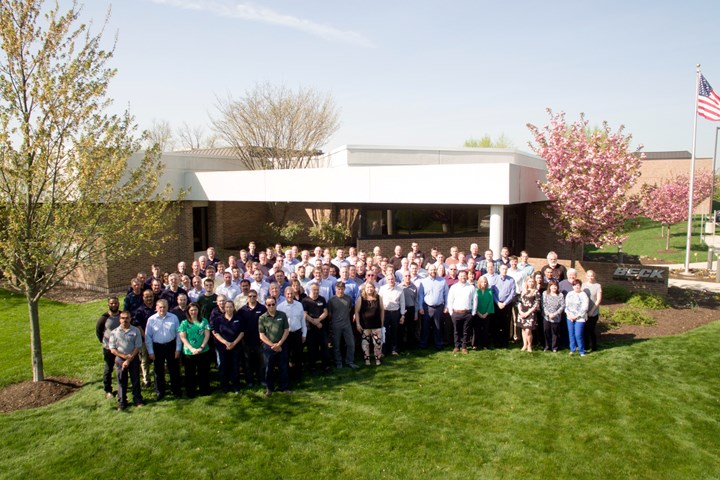Company Transitions to Employee Ownership and Thrives
Owner of Harold Beck & Sons chooses to transition to employee ownership as his succession plan.
#actuators #VMAnews

Doug Beck first heard about employee ownership a decade ago when his bank recommended it to him as a possible method of succession.
“I first realized that employee ownership was what I was going to do as I planned for retirement because I don’t have any children to take over the business,” said Beck. “I also wanted to retain the culture and success of the company moving forward without having to worry that a sale to a competitor or other strategic buyer would result in relocating the business, laying off workers or reducing benefits.”
Founded by Beck’s grandfather, Harold Beck & Sons began in Philadelphia with the initial goal of improving temperature control of industrial furnaces and the belief that their automation method could prove more effective than other companies. The business grew exponentially during the 1940s as World War II surged and continued to grow from there. In 1996, Doug Beck joined the company as president and began placing an emphasis on international expansion. Today, the company has 135 employees. Beck electric actuators are used in more than 70 countries and in more than a dozen industries to precisely position valves and dampers.
Harold Beck & Sons became employee owned through an Employee Stock Ownership Plan (or an ESOP) at the end of 2021.
Kevin McPhillips, executive director of the Pennsylvania Center for Employee Ownership (PaCEO), said, “Employee ownership can be a great tool for family-owned businesses who no longer have any family members to step up and take over. Often in these businesses, the employees do feel like family, so the transition to employee ownership is a natural one.”
Formalized by Congress in 1974, ESOP companies take on debt to buy out the owners and divide the ownership shares among the employees (who pay nothing). And unique within the tax code, ESOP companies pay no tax on profits for whatever portion of the company is owned by the employees. The employees work together to pay off the — supported by the tax savings — after which all future earnings are invested to grow the company and the value of the shares. Employees can then cash out their shares upon retiring or leaving the company.
Currently more than 300 companies in Pennsylvania are either partially or fully employee owned, while nationally, more than 5,000 other companies have ESOPs.
To make the transition, Beck & Sons hired SES ESOP Strategies. Initially, Beck had concerns that transitioning to a 100% ESOP right away would be too difficult. However, working with SES assuaged these concerns and Beck & Sons ultimately did convert to a 100% ESOP all at once.
“We’ve found that ESOPs do not have to be as complex as they’re often presented,” Ed Renenger, president and CEO of SES ESOP Strategies said. “Helping an owner think through the big picture benefits can often help simplify the purpose and structure for our clients.”
Since transitioning to the ESOP at the end of 2021, Beck says he has already noticed increased growth, excitement, and engagement within the company. “People really begin to take real ownership in the company and have more enthusiasm,” Beck said.
Bob Kritzer, the director of finance and administration at Beck & Sons, said the idea of employee ownership always resonated with him as he couldn’t imagine anyone else taking over the business. He also emphasized the sense of community employee ownership brings. “You become part of this community,” Kritzer said. “I was so impressed with how people want to help each other and share their stories. You join a whole different world of business.”
Now, Beck looks back on the last decade he’s known about employee ownership and wishes he’d have done it sooner. “Employee ownership is something that every business owner should consider,” Beck concluded. “I’m looking forward to more growth and engagement to come.”
RELATED CONTENT
-
Standards for Actuator/Gearbox Flanges
“Many variations in valve and actuator dimensions and characteristics have come into play especially now that we have worldwide vendors,” said Paul Souza, training manager at AUMA Actuators in a presentation at the Valve Manufacturers Association Virtual Valve Forum in November 2020.
-
Valve Basics: Electric Actuator Controls
Electric valve actuators control the opening and closing of valves. With a motor drive that provides torque to operate the valve, these actuators are frequently used on multi-turn valves such as gate or globe and also on ball, plug and other quarter-turn valves.
-
Fire Protection Solutions
Because of the potential harm and damage to people and property, fires and explosions are a major concern in refinery, gas processing, petrochemical and offshore, and many other types of facilities.










 Unloading large gate valve.jpg;maxWidth=214)